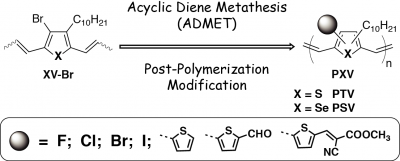Conjugated polymers (CPs) possessing low electronic bandgaps have attracted enormous amount of research efforts and found widespread applications in organic conductors, electrochromics, organic field-effect transistors (OFETs) and organic solar cells (OSCs). Specifically, OSCs are considered as promising low-cost and renewable alternative energy sources, and CP based solar cells (PSCs) have attracted the most attention due to their amenability to large throughput roll-to-roll and inkjet printing techniques. The attractiveness of low bandgap CPs for OSCs thus arises from the ability to absorb a larger portion of the red and near-IR photons in the solar spectrum, one of the prerequisites for high performance devices.
Among a plethora of examples, low bandgap poly(thienylene vinylene) (PTV) derivatives are a unique class of materials possessing high charge mobilities, environmental and thermal stability and recently discovered activated singlet fission (SF) processes. Various synthetic methods have been developed and refined over the years for PTV preparation, including earlier examples involving Gilch-type reactions and elimination from soluble polymeric precursors, McMurry coupling and Wittig-type reactions of aldehyde-containing monomers, transition metal catalyzed cross-coupling reactions, and more recently, acylic diene metathesis (ADMET) polymerization of thiophene monomers bearing propenyl double bonds at the thienyl 2,5-positions. Applications of these soluble PTVs in OSCs have been attempted but only low to moderate device efficiencies have been obtained. Despite morphology controllability issues, extremely short exciton lifetimes in PTVs caused by ultrafast non-radiative decay have been ascribed as the main causes for low OSC performance. Thus, in order for PTVs to be more applicable for OSCs and other optoelectronic applications in general, systematic structural modifications, optimization in physical/electronic properties and, most importantly, better understanding on structure-property relationships are necessary, all of which have been explored to a very limited extent mainly due to the limitations in structural variations through conventional synthetic methodologies.
We have developed a modular synthetic method, combining ADMET and post-polymerization modification (PPM) techniques, for the preparation of a series of PTV derivatives bearing cross-conjugated side-chains as well as analogous poly(selenylene vinylene) (PSV) derivatives. Through systematic variation of the heteroatoms and nature of the conjugated side-chain, we not only generate materials with novel structures and properties, but have gained a deeper understanding in structure-property relationships of these unique CPs. Ongoing efforts include synthesis of regio-regular versions of these substituted PXVs, inclusion of other heteroatoms, block copolymer synthesis, and device application.

Representative Publications.
“Unravelling the Enigma of Ultrafast Excited State Relaxation in Non-Emissive Aggregating Conjugated Polymers.” Datko, B. D.; Livshits, M. Y.; Zhang, Z.; Portlock, D.; Qin, Y.; Rack, J. J.* and Grey, J. K.* Phys. Chem. Chem. Phys. 2018, 20, 22159-22167. Link to Article
“Structurally Diverse Poly(thienylene vinylene)s (PTVs) with Systematically Tunable Properties through Acyclic Diene Metathesis (ADMET) and Postpolymerization Modification.” Zhang, Z. and Qin Y.* Macromolecules 2016, 49, 3318-3327. Link to Article
“Synthesis and Characterization of Poly(selenylene vinylene) and Poly(selenylene vinylene)-co-Poly(thienylene vinylene) through Acyclic Diene Metathesis (ADMET) Polymerization.” Zhang, Z. and Qin, Y.* ACS Macro Lett. 2015, 4, 679-683. Link to Article